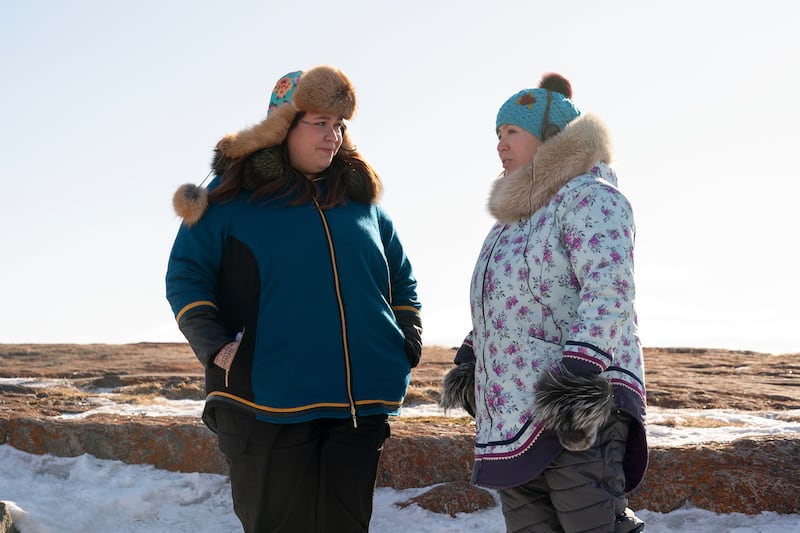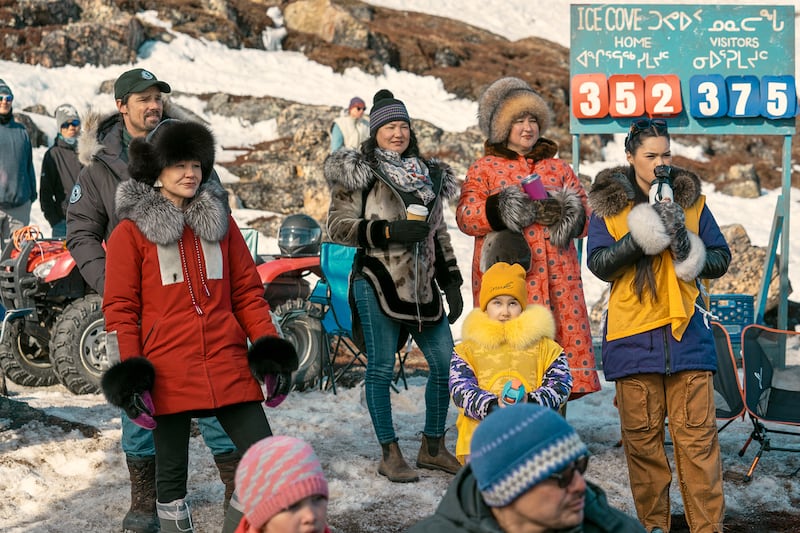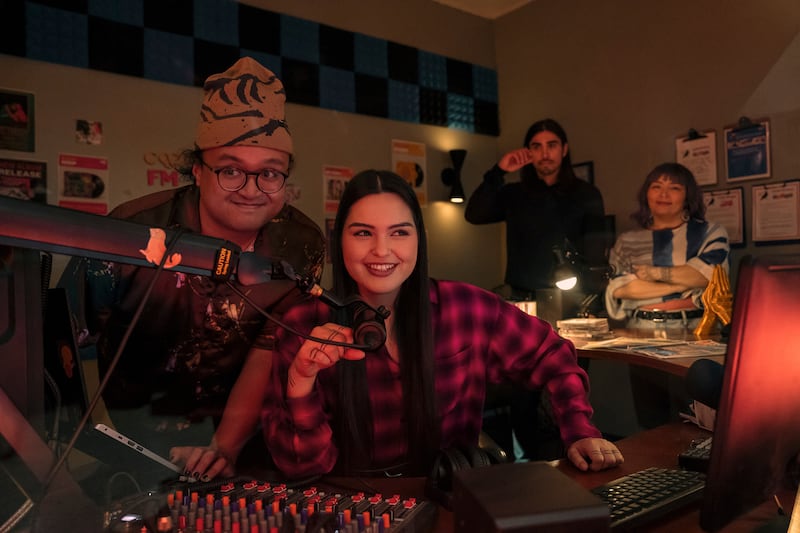On-again, off-again tariffs, threats to annex Canada as the 51st state, and Vice President Vance’s flop of an official trip to Greenland: what a moment for a sitcom set in Nunavut (the territory comprising most of Canada’s Arctic Archipelago ) to arrive on Netflix in the United States.
North of North, created by frequent collaborators Stacey Aglok MacDonald and Alethea Araquq-Baril, is a coming-of-age story about Siaja (an irrepressible, irresistible Anna Lambe), a young Inuit woman on a journey to self determination after early marriage and motherhood.
The series is full of sunny spring days, bright colors, and sprightly humor, while engaging with the sobering weight of history for Indigenous Canadians. North of North amply delivers on what Araquq-Baril describes as her and Aglok MacDonald’s intent to write a show audiences will “never feel like they have to brace themselves” to watch; its eight zippily-paced episodes go down very smoothly.
And the geopolitical stakes of the moment? Araquq-Baril’s response is an eloquent shrug informed by a long history with colonizing forces: The situation “feels like the latest in a long line of” episodes of dehumanizing rhetoric and policy created without consulting Inuit, she says. “For sure, it’s not fun to hear people talking about whether or not your sovereignty matters. But Arctic sovereignty has been important in global politics for many, many decades now.” Current inflaming news cycles are “not new – this is the latest wave of” such things, but “we’ve always been here, and we always will be, so we’ll cope with whatever happens.”

A vital aspect of Inuit survival has been the ability “to maintain who we are as a people, including our sense of humor, and our sense of joy and community connections to each other,” Araquq-Baril says. North of North is a literally shining example of using humor to cope with being turned into a political football.
As lifelong fans and creators of comedy, Araquq-Baril and Aglok MacDonald highlight the role that humor has always played in Inuit culture, as a tool for processing terrible things and strengthening community-wide bonds. At the first season’s midpoint, the uproarious episode “Walrus D*ck Baseball” is many things: a brisk primer in the particulars of Arctic baseball; a Parks and Rec-style glimpse of Ice Cove’s loathed rival town; and an opportunity cheer on Siaja as she continues to come into her own personally and professionally—all enriched and leavened with nearly nonstop jokes.
Two key supporting players for the series’ humor are the riot of colorful costumes and abundance of recent pop songs translated into Inuktitut that are featured in each episode. “We knew from the start that we wanted a modern, glossy show that’s warm and colorful, because so much of the media about the Arctic has portrayed it as kind of this cold and desolate place, and our lives are so different from that,” Arnaquq-Baril says.
The vibrant colors and florals found across North of North’s costume design reflects Arnaquq-Baril’s childhood memories of her “grandmother sewing with as much color as she could get her hands on” and contributes to making the show “an inviting space that people would immediately know is a fun watch that fills you with joy and happiness and laughter.”

Aglok MacDonald was particularly passionate about crafting the sound of the series, describing it as the fulfilment of a dream she and Arnaquq-Baril have shared since the earliest days of their careers. She commissioned covers of recent pop hits by Inuit musicians and gave an Inuktitut version of Dua Lipa’s “Levitating”, pride of place in the series pilot, playing it under a scene of Siaja towing supplies for Ice Cove’s Spring Festival on her mother’s skidoo (snowmobile).
Riit’s cover of that party-starter—retitled “Ikiaqqik (Levitating)”—announces that while Siaja might live far away from what outsiders consider the world’s major cultural centers, she’s not at all cut off from contemporary pop culture. Crucially, Aglok MacDonald says, the series provides a platform supporting “the talents that we have in our very small communities,” introducing them to audiences who might otherwise not know that “for such a small population, we sure have a lot of talent up here!”
North of North should easily find its place among the still-emerging cohort of series that are created, written, acted, and show-run by Indigenous artists, including Reservation Dogs (set in The Muscogee Nation in Oklahoma), Dark Winds (set in Navajo Nation in Arizona) and Rutherford Falls (whose upstate New York Minishonka tribe is fictional).
Those series didn’t exist when the duo were first working on North of North, Arnaquq-Baril says, “but when they came out, we felt like, Oh my God, yay! We’re all feeling a vibe!”

Aglok-MacDonald is hopeful that audiences who loved those earlier series will find and vibe with North of North, too, and believes that with each new series from Indigenous creators, writers can focus less on explaining basic aspects of a nation’s culture and more time on being “a little more immersive,” saying to audiences “welcome to this world now—you can just be here and enjoy it!”
When talking about their own influences and TV series that were touchpoints for North of North, both creators cite contemporary classics like Sex Education, Never Have I Ever, Insecure, and Atlanta, all of which successfully interweave laughter and tears, a quality that the two short-hand as “making us feel things”.
Using that as a guiding principle, North of North doesn’t shy away from bleak chapters in Inuit history, for example, engaging with the scars of Canada’s residential school system (a similar system was part of the U.S.’s attempts to forcibly assimilate Indigenous people).

So much of Siaja’s relationship with her mother, Neevee (Maika Harper) is informed by the consequences of Neevee’s experiences in a residential school and as a young woman afterwards. There’s anguish contained in the secrets Neevee has been carrying around for decades, and by finally addressing them directly, the two women start to find their way to a healthier relationship. It’s no wonder why one of North of North’s writers, Avia Johnston, describes the show as “a love letter to our communities and to our mothers.”
Aglok-MacDonald says the process of putting all of it—the joys and jokes as well as the pain and anger—on-screen was unexpectedly healing. “It allowed me to tap into and open up to stories and feelings that I’ve never said out loud, even to Alethea” over their many years as colleagues and close friends. “Having opportunities to share about something that hurt us in our upbringings and how we reckoned with it while writing a comedy opened me up in a lot of ways.” That sounds just like a recipe for a show that makes us both laugh and feel things.
The post Netflix’s ‘North of North’: The Canadian Sitcom That’s a Middle Finger to Trump’s Tariffs appeared first on The Daily Beast.




